DJI Mavic Pro
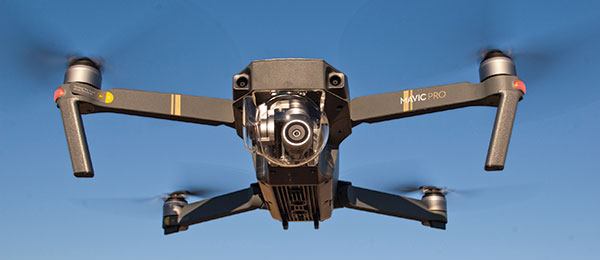
Written by Terry Dunn A portable aerial photography platform Product review As seen in the December 2017 issue of Model Aviation.
Bonus Video
Specifications
Type: Foldable multirotor Frame diameter: 13.2 inches Radio: 2.4 GHz system (included) Minimal flying area: Large park Price: $999 (base model); $1,299 (Fly More Combo) Components needed to complete: Smartphone Power system: Four outrunner brushless motors with 8.3 x 3 folding propellers; 3S 3,830 mAh LiPo battery (all included) Flight duration: 24 minutes Flying weight: 26.5 ouncesPluses
• Small footprint when folded. • Wide, customizable performance range. • 4K-resolution camera.Minuses
• In-flight orientation is difficult. • Crowded data displays.Product Review
There is no doubt that aerial photography (AP) multirotors have advanced tremendously throughout the past few years. Yet, this progress has seemingly been a path taken with baby steps. Each of the frequently released new designs has offered only slight improvements over previous models. What has been missing is a totally new approach that causes people to step back and rethink the practicality of AP multirotors. DJI’s Mavic Pro might just fill that void.Fold and Go
The true novelty of the Mavic Pro is its size. A ready-to-fly Mavic has a diameter of 335mm, which is only slightly smaller than the current 350mm standard. However, the Mavic’s arms and propellers can be folded inward to give the machine a significantly smaller footprint for storage and transport. Even the already downsized transmitter can be further reduced to cellphone-like dimensions. That’s a huge benefit for people who want an AP platform that they can easily fit into a backpack for use during a hike or bike ride.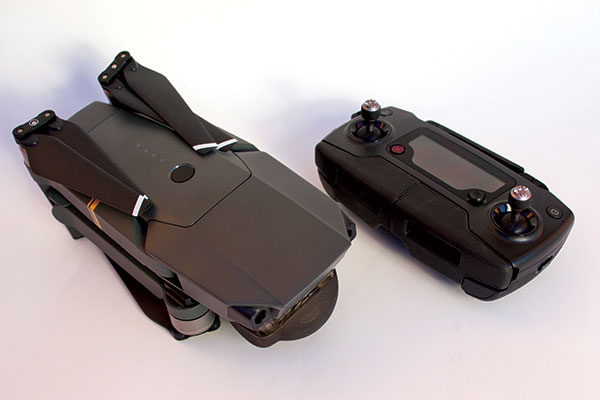
The primary appeal of the Mavic is that both the airframe and transmitter can be folded for easy transport.
Transportability is of little use in an AP platform if you have to sacrifice camera performance to get it. An advantage that the Mavic maintains over other currently available small AP quadcopters is its 4K-capable camera integrated into a three-axis gimbal. Therein lies the Mavic’s allure. It promises the same video performance of standard-size AP multirotors in a compact package that is much easier to manage. The Mavic Pro’s base model includes the quad, transmitter, one battery, three pairs of propellers, and an AC-powered battery charger. DJI also offers a combo package that has two additional batteries, more charging options, and a soft carrying case. The Mavic’s overall build quality is excellent. All of the parts are perfectly aligned and there are no blemishes to be found anywhere. I was particularly interested in analyzing the arm hinges. Any measure of fragility or sloppiness there could have a big impact on the performance and longevity of this quad. After several weeks of use and countless cycles, the hinges have proven to be robust and precise.
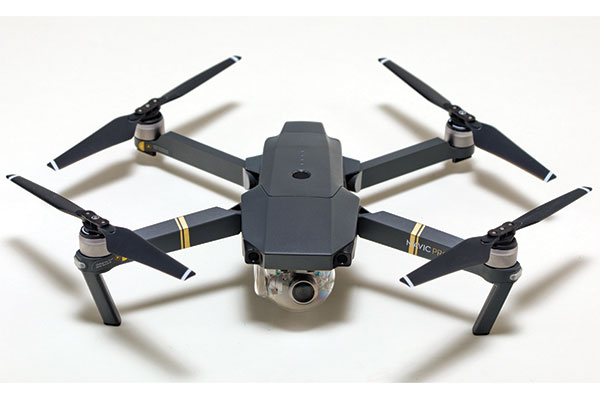
When unfolded and ready for flight, the Mavic’s footprint is comparable to many other AP multirotors.
The transmitter has some clever design features. Whereas most AP systems have you attach a smartphone or tablet to the top of your radio, your phone actually becomes an integral part of the Mavic’s transmitter. Two beefy arms fold down from the bottom of the transmitter to grip the phone. Cables are included to interface with iPhone and Android phones. When running the DJI GO 4 smartphone app, the phone serves as a control interface for many features of the Mavic and it also provides a real-time video display. I’ve been flying the Mavic with either an iPhone 5s or an iPhone 6s Plus attached to the transmitter. The two phones are significantly different in size, but both fit reasonably well within the grips. I find that the larger 6S Plus makes the overall feel of the transmitter more comfortable for my hands. If you have a protective cover on your phone, you’ll probably have to remove it before using it with the Mavic.
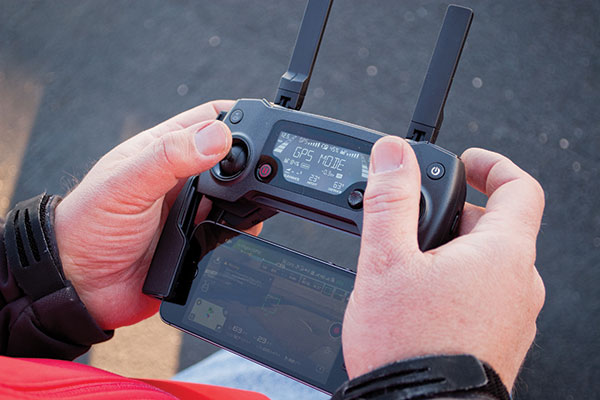
Your cellphone becomes an integral part of the Mavic’s transmitter. A wide range of cellphones can be utilized.
Preparing for Flight
My advice to the owner of any new AP multirotor has always been to read the manual from cover to cover before heading to the field. As these machines continue to become more advanced with increasingly autonomous features, they also become more complex and further removed from traditional RC models. No amount of previous RC experience can substitute for knowing how a quad will react when you push a certain button. Figuring things out in the air is a risky endeavor. Recently, even my “read the entire manual” advice has become insufficient. It seems that software updates and enhancements frequently appear—often outpacing revisions to the manual. Make sure that you always have the latest version of the manual handy. You might also want to check online forums and videos for recent changes. I used all three resources to get up to speed with the Mavic. The Mavic has such a broad range of features that it would be impractical to cover them all in this review. Many of those features are meant to assist users who are completely new to RC flying. I’ll focus on the aspects that are most likely to be appreciated and used by experienced modelers.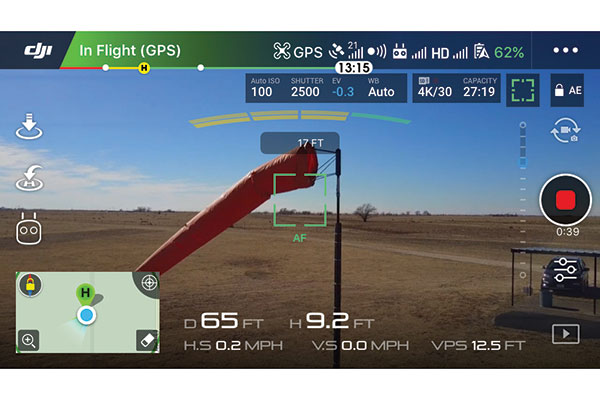
The DJI GO 4 smartphone app provides a real-time video link and a wide range of flight data. It is useful information, but the busy screen can be confusing at times.
There are two primary flight modes on the Mavic: Positioning (P-mode), and Sport (S-mode). You can select either mode during flight with a physical switch on the transmitter. P-mode utilizes GPS as well as downward-facing optical and ultrasonic sensors to maintain altitude and position. There are also forward-facing cameras that are part of the Mavic’s obstacle avoidance system. As you approach something that is blocking your flight path, the system will warn you and eventually bring the quad to a halt if you do not change your course. Using obstacle sensing will limit your top flight speed to 22 mph. Disabling the forward cameras bumps the maximum P-mode speed to 36 mph. Within P-mode, there are several “intelligent” flight modes that are selectable via the app. You can have the Mavic maintain a constant height above undulating ground using Terrain Follow Mode. It is even possible to command the camera to take a photo of you using only a series of hand gestures. For me, the most useful intelligent mode is Tripod. This mode makes the Mavic extremely docile, with a top speed of slightly above 2 mph. You’ll want to use Tripod when flying among trees and other tight locations, or when you need to capture extremely smooth video footage. Flipping the switch to S-mode disables the obstacle avoidance system, but GPS positioning is still active. Top speed edges up to 40 mph and the controls become more responsive. S-mode falls short of being aerobatic, but it is certainly lively. I think it’s about as aggressive as you’d want to get with a gimbal and camera onboard. It’s nice to be able to cut loose with a few hot laps to break up a session of smooth video flying.
Flying the Mavic Pro
It only takes a minute or so to unfold the Mavic and prepare the transmitter. It typically takes less time to unfold the Mavic than it does to install the propellers on any of my other multirotors.
With its small brushless motors and folding propellers, the Mavic Pro can reach speeds up to 40 mph.
A clear plastic cover surrounds the nose-mounted gimbal/camera. I kept the cover in place for the first few flights. When I reviewed the resulting video, I noticed frequent problems with glare and occasional shaky footage. I removed the cover for all subsequent flights and have not had any further camera issues. Like most AP multirotors, the Mavic’s flight performance can be tailored to your preferences. The stock settings, however, felt quite natural to me. In both P-mode and S-mode, control authority in all axes is well-balanced. My only negative observation is that the quad pitches aggressively to brake when you release the right control stick. This movement is sometimes visible in the corresponding video footage. Of course, this braking action is one of the parameters that you can modify within the app. The fundamental task of flying the Mavic Pro is simple and enjoyable. It’s a versatile little camera platform that performs well. Things get more complex, however, when the app comes into play. It displays a lot of useful data—perhaps too much. It sometimes takes more than a quick glance downward to find the information that you’re looking for. The same is true of the transmitter’s built-in screen. If you haven’t familiarized yourself with the layout of these displays, they can easily become more distracting than informative. Visual orientation is an inherent problem with multirotors. The impact is somewhat exaggerated with the Mavic because of its relatively small size and overall dark color scheme. It might be helpful to add a splash of bright color in strategic areas to improve visibility.
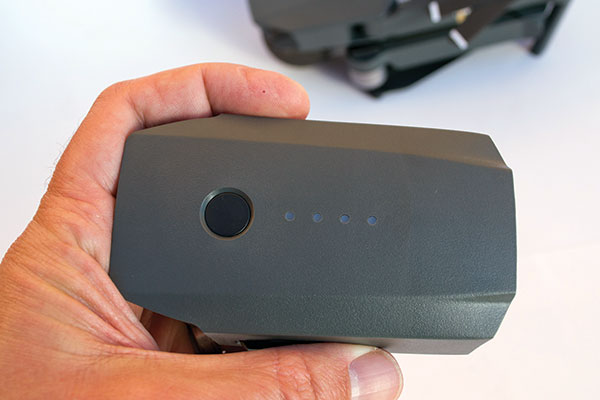
The proprietary 3S 3,830 mAh flight battery can provide flights lasting longer than 20 minutes.
A proprietary 3S, 3,830 mAh LiPo battery powers the Mavic. DJI claims that 27-minute flights are possible. In real-world conditions, I was able to achieve 24-minute flights before becoming concerned about the remaining battery power. The app gives you plenty of warning before things get critical. It will also land the Mavic for you if you choose to ignore its pleas.
Capturing Photos and Video
Despite the amazingly small size of the Mavic’s three-axis gimbal and integrated camera, it is capable of capturing impressive aerial footage. The Mavic is easy to fly smoothly and the gimbal dampens out all of the unavoidable little bumps. I experienced occasional lag with the video downlink signal, but it was seldom noticeable. This made the task of framing shots a quick process. This is the first airborne camera I’ve used that actually allows you to choose a focus area. All of my other cameras have simply been set at infinite focus. This is a very handy feature, as long as you remember to set the focus where you want it. A slightly out-of-focus picture is often hard to notice on the small screen during flight, but you’ll realize it right away when you upload the footage to your computer! Like so many other aspects of the Mavic, the camera has many configuration options (ISO, white balance, shutter speed, etc.). You can set everything to automatic or manually select whatever setting fits the situation. The camera can capture 4K-resolution video at up to 30 frames per second. A number of alternate resolutions and frame rates are available, including 720P at 120 frames per second. Photographs max out at 4,000 x 3,000 pixels. Your media is stored on an onboard micro SD memory card.Final Approach
There’s no question that the Mavic Pro represents a significant shift in thinking for AP multirotors. It’s no longer necessary to manhandle a large model to get high-quality 4K footage. The stowed Mavic is compact and light enough that it poses very little travel overhead. Just drop it in your bag and go.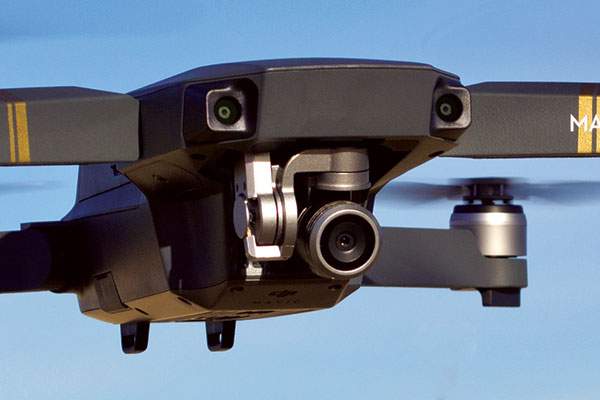
The Mavic’s 4K-capable camera and integrated three-axis gimbal provide impressive video performance in a small package.
As capable as the Mavic is, it is probably not a great choice for modelers who prefer to simply open the box and go flying. Those who do so could easily find themselves overwhelmed by this quad’s countless options and busy data displays. It is a different story, however, for those who invest the time to become acquainted with all of the DJI Mavic Pro’s features and capabilities. I think they will find that it is a tremendously versatile and adaptable platform. It is a multirotor that commands your attention, but rewards you with a compact machine that can be uniquely tailored to your preferences. —Terry Dunn [email protected]










Add new comment